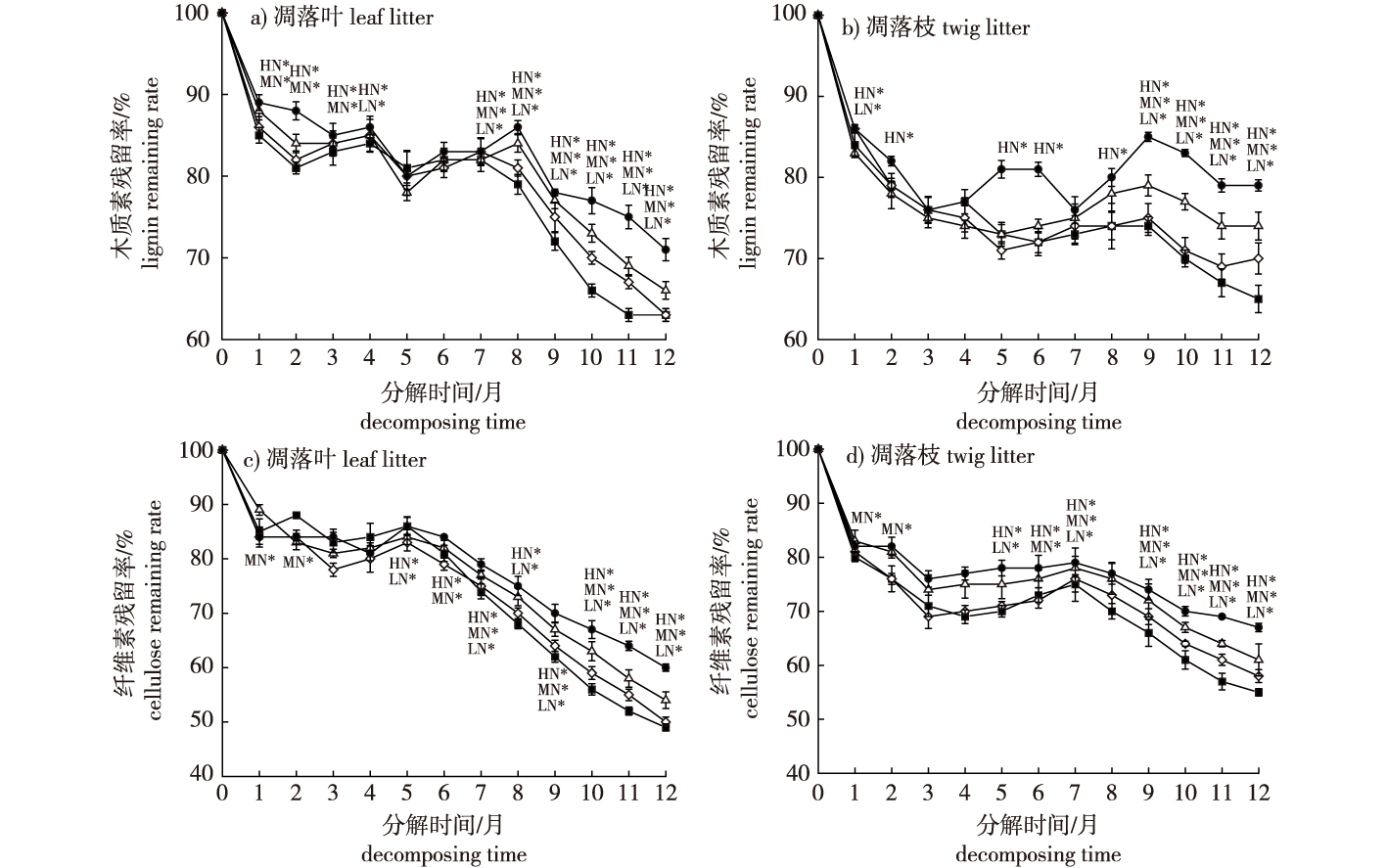 PDF(2089 KB)
PDF(2089 KB)


滇中高原川滇高山栎凋落叶、枝分解过程对模拟氮沉降的响应
邢进梅, 王克勤, 宋娅丽, 付宏伟
南京林业大学学报(自然科学版) ›› 2024, Vol. 48 ›› Issue (4) : 191-199.
 PDF(2089 KB)
PDF(2089 KB)
 PDF(2089 KB)
PDF(2089 KB)
滇中高原川滇高山栎凋落叶、枝分解过程对模拟氮沉降的响应
The litter decomposition of fallen leaves and branches from sub-alpine Quercus aquifolioides of central Yunnan Plateau under simulated nitrogen deposition
【目的】氮(N)沉降增加通过影响凋落物分解过程中碳(C)、氮(N)元素的有效性,进而影响生物地球化学循环中的碳和养分平衡。通过研究模拟N沉降下川滇高山栎(Quercus aquifolioides)凋落物分解速率及养分含量变化特征,为川滇高山栎森林生态系统的有效管理提供参考。【方法】以滇中新平县磨盘山川滇高山栎林为研究对象,以尿素(有效成分CH4N2O)为氮源,采用尼龙袋法进行N沉降处理以及凋落物原位分解试验,4个N沉降水平为:对照[CK,0 g/(m2·a)]、低氮[LN,10 g/(m2·a)]、中氮[MN,20 g/(m2·a)]和高氮[HN,25 g/(m2·a)],每月施氮1次,持续12个月后测定凋落叶及枝质量残留,及其木质素、纤维素和C、N、P、K含量变化。【结果】①分解1 a后,各N沉降处理凋落叶(0.84%~3.87%)、枝(1.67%~3.30%)质量残留率均显著增加(P<0.05),说明随时间延长,凋落物分解被抑制,且抑制强度与施氮水平成正比;②凋落叶、枝分解系数变化范围分别为0.271~0.368和0.167~0.218 kg/(kg·a),凋落枝C/N(69.02)和木质素氮比(54.65)高于凋落叶的值(52.09和44.42),叶分解速率快于枝;③凋落物化学组成会影响凋落物质量残留率,表现为凋落物质量残留率与凋落叶和枝的N、P含量呈极显著负相关,与C、纤维素含量,C/N、C/P、木质素氮比、纤维素氮比等比值呈极显著正相关。【结论】①N沉降抑制了凋落物的分解,且随施氮水平的增加,抑制作用明显增强;②初始养分含量会影响凋落物的养分固持和释放,其中,N含量、C/N、木质素氮比是凋落物分解过程中的重要影响因子。
【Objective】Increased nitrogen (N) deposition affects carbon (C) and N availability by affecting the litter decomposition process, after which it affects the C-nutrient balance of the biogeochemical cycle. In this study, the nylon mesh bag method was used to study the decomposition rate and nutrient content changes of Quercus aquifolioides litter under simulated N deposition, providing a reference for an effective Q. aquifolioides forest ecosystem management.【Method】The in situ litter decomposition test was carried out in the Q. aquifolioides forest of Mopanshan in Xinping County, central Yunnan Province. Four N levels were applied using the nylon mesh bag method, with urea (CH4N2O) as the N source for in situ decomposition of litter and N deposition treatment. The four N deposition levels were: control [CK, 0 g/(m2·a)], low N [LN, 10 g/(m2·a)], medium N [MN, 20 g/(m2·a)] and high N [HN, 25 g/(m2·a)]. Leaf litter and twig mass remaining, lignin, cellulose, and C, N, P and K contents were then measured.【Result】① After one year of decomposition, the N deposition treatment significantly increased the mass remaining rate (P<0.05) of leaf litter (0.84%-3.87%) and twig (1.67%-3.30%). The litter decomposition was inhibited, and the inhibition intensity was proportional to N content application. ② Variation coefficients of leaf and twig litter decomposition were 0.271-0.368 and 0.167-0.218 kg/(kg·a), respectively. The lhe C/N (69.02) and lignin/N (54.65) of twig litter were significantly higher compared with leaf litter (52.09 and 44.42, respectively). Leaf decomposition rate was faster compared with that of twig. ③ The chemical composition of the litter affected its mass remaining rate, which was negatively correlated with N and P contents of leaf and twig litters, and positively correlated with C, cellulose, C/N, C/P, lignin/N and cellulose/N.【Conclusion】The N deposition inhibits litter decomposition, and this effect is significantly enhanced by increased nutrient content. Initial nutrient content effects nutrient retention and litter release processes, among which N level, C/N and lignin/N are important influencing factors.

凋落叶 / 凋落枝 / 分解速率 / 木质素 / 纤维素 / 滇中高原 / 川滇高山栎 / N沉降
leaf litter / twig litter / decomposition rate / lignin / cellulose / central Yunnan Plateau / Quercus aquifolioides / N deposition
| [1] |
岳可欣, 龚吉蕊, 于上媛, 等. 氮添加下典型草原凋落物质量和土壤酶活性对凋落物分解速率的影响[J]. 草业学报, 2020, 29(6):71-82.
|
| [2] |
于美佳, 叶彦辉, 韩艳英, 等. 氮沉降对森林生态系统影响的研究进展[J]. 安徽农业科学, 2021, 49(3):19-24,27.
|
| [3] |
|
| [4] |
|
| [5] |
汪星星, 廖文海, 许祖元, 等. 森林凋落物分解影响因素的研究进展[J]. 北方园艺, 2022(4):126-132.
|
| [6] |
段娜, 李清河, 多普增, 等. 植物响应大气氮沉降研究进展[J]. 世界林业研究, 2019, 32(4):6-11.
|
| [7] |
|
| [8] |
|
| [9] |
|
| [10] |
|
| [11] |
|
| [12] |
|
| [13] |
莫江明, 薛璟花, 方运霆. 鼎湖山主要森林植物凋落物分解及其对N沉降的响应[J]. 生态学报, 2004, 24(7):1413-1420.
|
| [14] |
胡宗达, 刘世荣, 史作民, 等. 川滇高山栎林土壤氮素和微生物量碳氮随海拔变化的特征[J]. 林业科学研究, 2012, 25(3):261-268.
|
| [15] |
曹丽花, 尹为玲, 刘合满, 等. 西藏东南部色季拉山主要类型森林叶片和枯落物养分含量特征[J]. 生态学报, 2019, 39(11):4029-4038.
|
| [16] |
贾钧彦. 西藏高原大气氮湿沉降研究[D]. 拉萨: 西藏大学, 2008.
|
| [17] |
杨开军, 杨万勤, 庄丽燕, 等. 四川盆地西缘都江堰大气氮素湿沉降特征[J]. 应用与环境生物学报, 2018, 24(1):107-111.
|
| [18] |
李仰征, 雷兴庆, 薛晓辉, 等. 纱帽山不同海拔大气氮湿沉降通量差异及递变规律的数学模拟[J]. 环境科学学报, 2020, 40(9):3180-3189.
|
| [19] |
余功友, 杨常亮, 刘楷, 等. 云南阳宗海大气氮、磷沉降特征[J]. 湖泊科学, 2017, 29(5):1134-1142.
|
| [20] |
|
| [21] |
鲍士旦. 土壤农化分析. 3版[M]. 北京: 中国农业出版社, 2000.
|
| [22] |
张毓涛, 李吉玫, 李翔, 等. 模拟氮沉降对天山云杉凋落叶分解及其养分释放的影响[J]. 干旱区研究, 2016, 33(5):966-973.
|
| [23] |
涂利华, 胡红玲, 胡庭兴, 等. 华西雨屏区亮叶桦凋落叶分解对模拟氮沉降的响应[J]. 植物生态学报, 2012, 36(2):99-108.
|
| [24] |
李仁洪. 华西雨屏区慈竹林凋落物分解、养分释放及其对模拟氮沉降的响应[D]. 雅安: 四川农业大学, 2009.
|
| [25] |
|
| [26] |
周世兴, 黄从德, 向元彬, 等. 模拟氮沉降对华西雨屏区天然常绿阔叶林凋落物木质素和纤维素降解的影响[J]. 应用生态学报, 2016, 27(5):1368-1374.
|
| [27] |
|
| [28] |
涂利华, 戴洪忠, 胡庭兴, 等. 模拟氮沉降对华西雨屏区撑绿杂交竹凋落物分解的影响[J]. 生态学报, 2011, 31(5):1277-1284.
|
| [29] |
马慧君, 张雅坤, 许文欢, 等. 模拟氮沉降对杨树人工林土壤微生物群落碳源利用类型的影响[J]. 南京林业大学学报(自然科学版), 2017, 41(5):1-6.
|
| [30] |
|
| [31] |
|
| [32] |
铁烈华, 张仕斌, 熊梓岑, 等. 华西雨屏区常绿阔叶林凋落叶分解过程中木质素降解对模拟氮、硫沉降的响应[J]. 林业科学研究, 2019, 32(2):25-31.
|
| [33] |
铁烈华, 符饶, 张仕斌, 等. 华西雨屏区常绿阔叶林凋落叶分解过程中纤维素降解对模拟氮、硫沉降的响应[J]. 应用与环境生物学报, 2019, 25(1):16-22.
|
| [34] |
|
| [35] |
林成芳, 彭建勤, 洪慧滨, 等. 氮、磷养分有效性对森林凋落物分解的影响研究进展[J]. 生态学报, 2017, 37(1):54-62.
|
| [36] |
|
/
| 〈 |
|
〉 |